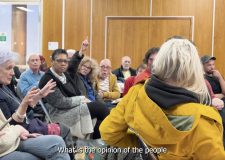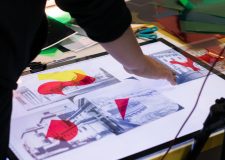A greener meeting of minds for Brighton politicians
Some of the big transport & environmental issues facing Brighton & Hove were addressed at one marathon meeting.
Frank le Duc reports

Bus and cycle lanes, parking, communal bins, pollution and dog fouling were among a dozen substantial items debated at a long meeting on a hot afternoon at Hove Town Hall last week. It was the first meeting of a new committee of councillors – a merger of two committees which was aimed in part at saving taxpayers’ money. The Environment, Transport and Sustainability Committee is responsible for some of the most sensitive subjects handled by local politicians.
Like almost all Brighton and Hove City Council committees, the meeting opened with the chance for voters to have their say. The item is headed “Public involvement” and covers petitions, written questions and deputations. This part of the meeting is often one of the most interesting.
Those addressing the assembled councillors are sometimes less well versed in the etiquette of committee meetings than the elected members and officials. Frustrations are voiced forcefully by a few. And it can on occasion be like listening to the child in the Hans Christian Andersen fairy tale, The Emperor’s New Clothes.
One of the petitions last week urged the council to rename the roundabout on the A259 at Ovingdean. But the request to call it Veterans Roundabout was merely noted. Any change will involve a strict process. The roundabout is overlooked by the prominent Blind Veterans UK premises formerly known as St Dunstan’s. Another petition looked at the detail of parking bays in Stanford Avenue and suggested pragmatic minor changes. The petitioner will have to wait though while officials monitor how the resident parking and pay and display scheme there is working.
Two deputations touched on proposals to build bus lanes in Edward Street. The “Better Bus Area” scheme has won £3.5 million from the government. The council and Brighton and Hove Buses are jointly putting in a further £2 million. The scheme is part of plans to revitalise the bottom end of Edward Street. It was prompted in part by American Express building new offices. Its old blue and white building faces demolition.
At the same time, pressure on parking spaces at the Royal Sussex County Hospital has grown. It has become increasingly important for councillors and officials to look at ways to encourage more people to go to and from the hospital by bus. The £420 million revamp of the Royal Sussex site will create more parking spaces. But the revamp is expected to take until the end of the decade. Public transport is a vital part of the mix and not just while building work is taking place.
RETHINK REQUESTED
One of the deputations came from people living in Carlton Hill, the street immediately to the north of Edward Street. The other came from people in St James’s Street, the road immediately to the south. Both wanted a rethink. Carlton Hill residents fear that their street will become even more of a rat run. The presence of a primary school heightens their concerns about safety.
The deputation about St James’s Street presented by the Community Action Group floated the idea of pedestrianising the bottom end. Members of the group want eastbound buses rerouted along Edward Street. They said that the proposed changes to Edward Street should have been considered along with ways to boost trade in St James’s Street. The council has to balance a desire for joined up government or a holistic approach to policy-making with the need to define clearly the limits of any scheme.
Committee members also have the chance to have questions answered. But even councillors who are familiar with the way democratic decision-making works can become frustrated by aspects of the process. Councillor Alan Robins asked about dangerous junctions near two schools in Portslade – Benfield Primary and St Peter’s Infant School.
He said: “I’m told by the road safety team they are currently only considering work on junctions where there have been eight injury-causing accidents in three years. “Can you confirm this is the case and when asked by parents, ‘will a child need to be injured before something is done’, should I answer, ‘no, it will take eight actually?’”
The committee chairman, Councillor Pete West, said that it was necessary to prioritise the way in which the council’s limited funds were spent. He wanted officials to target places with the most and worst accidents. He said that there had been one minor accident in the places in question.
Councillor Graham Cox asked how many people had been prosecuted by the council for dog fouling in the past 12 months. Councillor West said: “Two fixed penalty notices were issued for fouling over the last 12 months. One was withdrawn due to insufficient evidence and the other was not paid. That resulted in court action and a successful prosecution. The court sentenced the dog owner to a £100 fine, £350 costs and £15 victim surcharge.”
He said that the council had received 432 complaints about dog fouling and that the small animal welfare team – the equivalent of 4.1 full-time staff – had carried out 315 patrols. They had dealt with 328 stray dogs and investigated 254 dangerous dogs or dog attacks. He added: “We have a mixed approach that includes education, advice and enforcement.”
COMMUNAL RECYCLING
It was only after this had been cleared up that the main business was tackled by councillors in a meeting that lasted about four and a half hours. The first substantive item was to approve the introduction of communal recycling bins from Kemp Town to Sackville Road in Hove. The new bins will take up 272 parking bays which will upset some people. But recycling rates are low in the areas where there are currently communal bins for general rubbish.
Then it was off to the countryside, although not literally. The committee was asked to agree the aims and the terms of reference for a new City Downland Estate Advisory Board. The council has nearly 12,000 acres of farmland, mostly in the South Downs National Park. Last year a decision was taken to bring the management of the rural estate back in house.
The next item asked councillors to endorse the application for Brighton, Hove and Lewes to become a biosphere reserve. The application will be made to the United Nations Educational, Scientific and Cultural Organisation (UNESCO), probably in September. Among the benefits, the council hopes that green tourism and the green industries locally would receive a boost, helping sustain not just the environment but the local economy.
Air pollution and measures to tackle it were also on the table. Members were asked to approve an “air quality management area” more tightly focused on where nitrogen dioxide (NO2) levels are being recorded above the legal limits. And to approve ideas to help us all breathe more easily, including restrictions on the worst-offending vehicles with the creation of a low emission zone.
It will surprise few people that North Street, Queen’s Road and St James’s Street in Brighton have problems with air pollution as do some other heavily used bus corridors. And anyone living near the route used by lorries between Shoreham Harbour and the Brighton bypass knows that it sometimes seems filled with fumes. But Rottingdean High Street is also affected. Narrow streets with high-sided buildings, especially on hills, are particularly vulnerable.
The final proposal involved extending the Old Shoreham Road cycle lane further west to the Nevill Road and Sackville Road traffic lights. A report on the matter took up more than 100 pages of an agenda and reports pack stretching to almost 600 sides of A4. War And Peace is light reading by comparison. The committee is next due to meet on Tuesday 8 October.




















